Choosing the right outdoor wall lights is crucial for your home. The type of light you need depends on your specific requirements. Below, we’ve compiled information to help you make the right choice.
Outdoor Lighting Types
Choosing outdoor lighting depends on your specific needs. Do you need to deter burglars or just illuminate dark areas for occasional use, like reaching a shed in the garden?
Below are the most common types of outdoor lighting and their ideal uses.
Welcome Lighting
Welcome lighting, also known as courtesy lighting, is typically placed near the main entrance, such as the front door.
These lights serve multiple purposes: they offer a sense of security to visitors, illuminate the surroundings for better visibility, and help homeowners identify guests.
The most common types include four or six-sided lanterns and glass down lanterns, either wall-mounted or as a downward fixture.
Many welcome lights are equipped with sensors like PIR or Dusk Till Dawn for automatic activation and deactivation.
While traditional incandescent bulbs were once common, LED bulbs are now preferred for their energy efficiency.
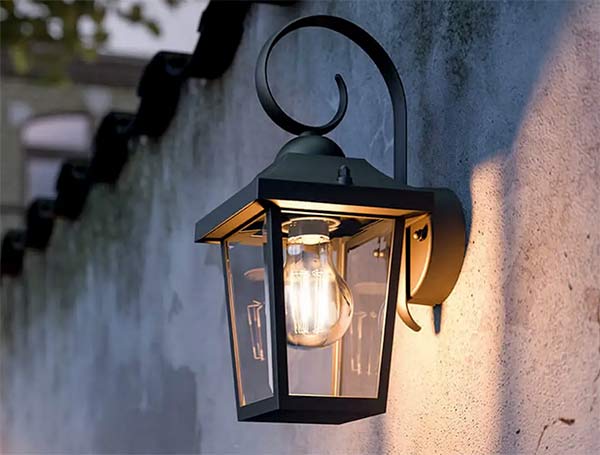
Lantern-style wall light ideal for use as a welcome light
Mood Lighting
Mood lighting enhances outdoor spaces like pathways, patios, BBQ areas, and seating spots.
It’s designed to create a relaxing ambiance while providing sufficient illumination for visibility.
Additionally, mood lighting can highlight garden features like plants, trees, and ponds.
You can find mood lighting in various styles, including options with colored bulbs.
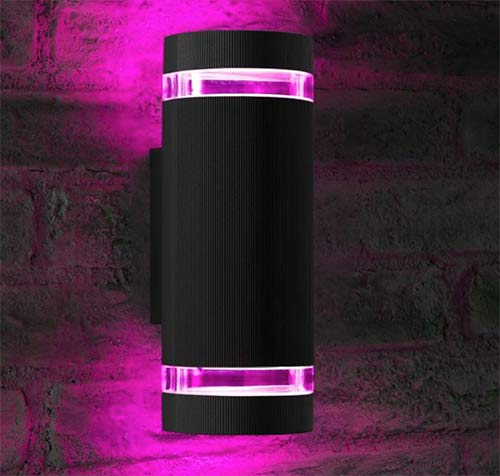
Auroaglow remote control colour changing wall light – Image courtesy of Auraglow
Floodlighting / Security Lighting
Exterior lights, particularly security or flood lights, are essential for home security.
Security lights come in various types, styles, and power outputs to suit different needs.
A popular choice is the PIR floodlight, equipped with a motion sensor that activates the light when movement is detected, ideal for illuminating large dark areas.
Some exterior lights feature a Dusk to Dawn Sensor, operating from dusk till dawn, providing continuous lighting during the night.
Once installed, they require minimal maintenance, especially if equipped with energy-efficient LED bulbs.

LED security flood light with PIR sensor
Traditional Outdoor Lighting
Traditional outdoor lights typically feature antique-looking designs like the four or six-sided lanterns or glass down lanterns.
These lights are often wall-mounted with an upward or downward orientation, usually painted in matte black for an antique appearance.
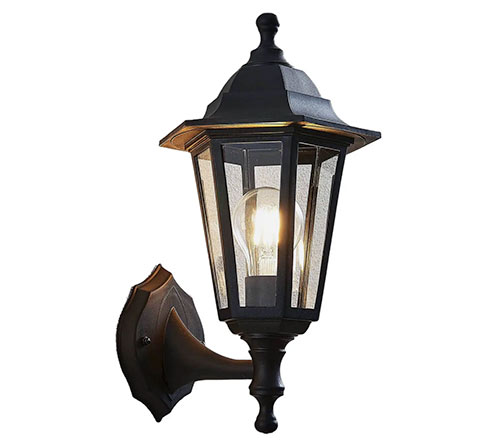
Traditional black exterior wall light
Contemporary Lighting
Unlike traditional lights, contemporary outdoor lights feature modern and innovative designs.
While they typically complement modern properties, contemporary lights come in various styles like bollards, welcome lights, and security lights, making them suitable for any property type.
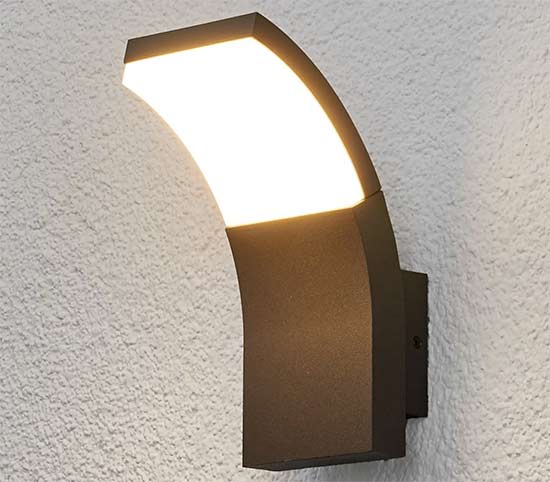
Contemporary style exterior wall light – Image courtesy of lights.co.uk
Accent Lighting
Accent lighting directs light to specific areas or objects, commonly used indoors for alcoves and artwork. Outdoors, it can highlight pathways or illuminate features like ponds, trees, and shrubs.
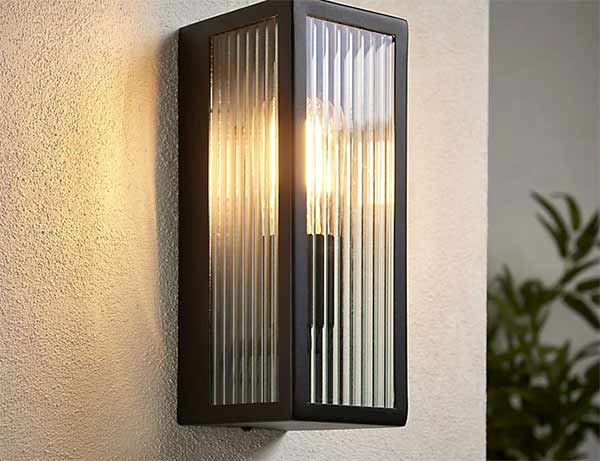
Contemporary accent light – Image courtesy of trade-point.co.uk
Bollard Lighting
Bollard lights, commonly seen in commercial areas like car parks and office complexes, can also enhance residential settings by lining garden pathways, patios, or gateways. Originally mains-powered, modern options include solar-powered versions with LED bulbs. Available in various sizes and styles to match different preferences.
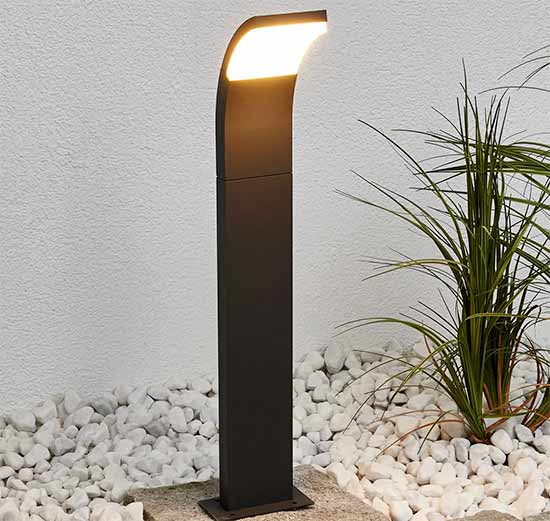
Modern contemporary bollard light
Solar Lighting
Outdoor solar lighting operates similarly to traditional options but uses built-in solar panels to charge internal batteries during the day for nighttime use. Many models include PIR or dusk-to-dawn sensors to conserve battery power. Their popularity stems from easy installation without wiring to the mains and cost savings on electricity bills.
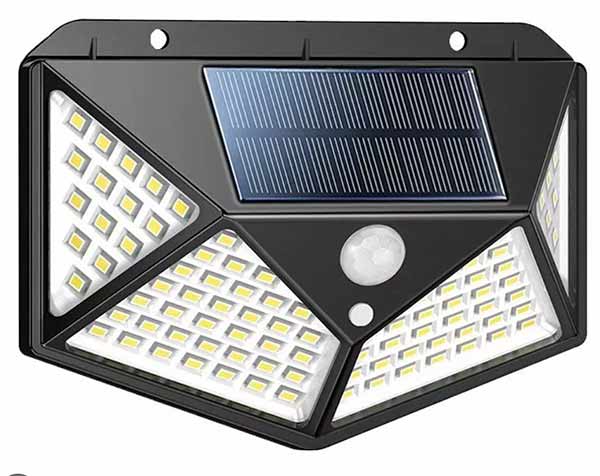
Budget LED solar wall light
Choosing the Right Exterior Light Brightness
The brightness of your exterior light depends on the area you want to illuminate. For large areas with dark spots, opt for LED floodlights ranging from 100W to 200W. For smaller spaces, 4 to 11 Watt LED bulbs (equivalent to 30W to 80W incandescent or halogen bulbs) should suffice.
Consider where the light shines — if it’s only on your property, it’s fine. But if it spills onto a neighbour’s space or shines into their windows, expect complaints, and quite rightly so!
Understanding PIR Sensors in Exterior Lighting
Many modern exterior lights include built-in PIR sensors (passive infrared), which activate the light when motion is detected.
These sensors often have adjustable settings for day/night sensitivity, detection angle, and timer delay to prevent unnecessary activation and conserve energy.
This setup is commonly known as dusk-to-dawn lighting, as it automatically responds to the ambient light conditions.
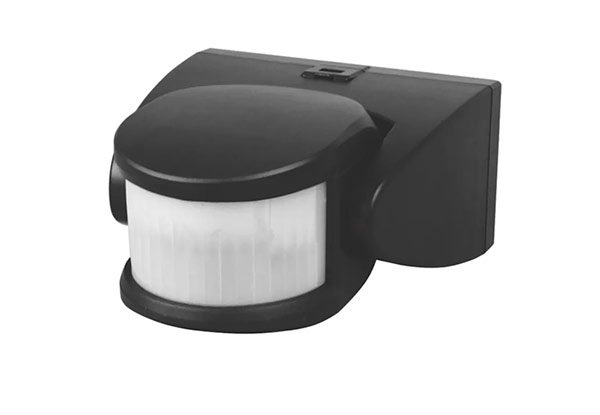
LAP PIR sensor
Choosing Between Warm and White Outdoor Lights
Warm white lights, around 2700k, are often preferred for outdoor spaces as they provide a comforting and relaxing ambiance. However, cooler white lights can highlight vegetation such as trees and flowers effectively.
This consideration has become more relevant with the widespread use of LED bulbs, which traditionally emit a warm white light similar to halogen bulbs.
Optimal Placement for Exterior Lights
When installing exterior wall lights, position them to maximise their lighting coverage and sensor detection area. This ensures effective illumination and triggers when someone approaches.
Ensure safety by avoiding direct eye contact with the lights. Proper positioning is crucial to prevent any potential harm to the eyes.
For seating or relaxing areas, consider glare and place the lights strategically to avoid discomfort.
Be mindful of neighbours to prevent light intrusion into their homes, as it may cause discomfort.
Powering Exterior Wall Lights
Exterior wall lights can be powered in two main ways: through mains electricity or using integrated solar panels with rechargeable batteries.
Mains-powered lights are typically connected to existing home circuits, often via a nearby light switch. Proper wiring procedures, including earth connections for metal units, must be followed, adhering to safety and building regulations.
For more detailed instructions on wiring, consult our project on wiring exterior wall lights, or seek assistance from a qualified electrician.
It’s essential to adhere to safety standards such as the IEE Wiring Regulations (BS 7671) and Part P of the Building Regulations 18th edition. All work must be carried out by a Part P registered electrician.
Additionally, use caution with bulb wattage, ensuring compatibility with manufacturer recommendations to prevent overheating.
When installing powerful lights or multiple fixtures, consider connecting them to a separate Residual Current Device (RCD) in your consumer unit to prevent overloads. Your electrician will advise on the best course of action to take.
Additionally, in most cases, 1mm2 (exterior diameter 11m2, 2 core) SWA cable should be used externally to ensure fully protection, but again your electrician will provide full details on this. For more information see our installing an outdoor socket project for information.
For detailed instructions on mounting light units to exterior walls, refer to our fixing to masonry project.
Exterior Wall Light Regulations
Only hire a registered Part P electrician for wiring and electrical work to ensure compliance with safety standards, regulation adherence and to avoid invalidating home insurance. This is the law!
Outdoor light fittings must be suitable for outdoor use, tested to BS EN 60598, and bear a CE mark.
Ensure a minimum IP rating of 44 or higher for outdoor light fittings to protect against moisture.
Consider maintenance requirements when selecting materials for fittings, especially in corrosive environments near the sea. Opt for marine-grade stainless steel or plastic constructions if corrosion is a concern.
Refer to manufacturer care instructions for proper maintenance guidelines.
Choosing outdoor wall lights for your home can be overwhelming due to the abundance of options. Prioritize lights that adequately illuminate your desired area without consuming excessive energy.

